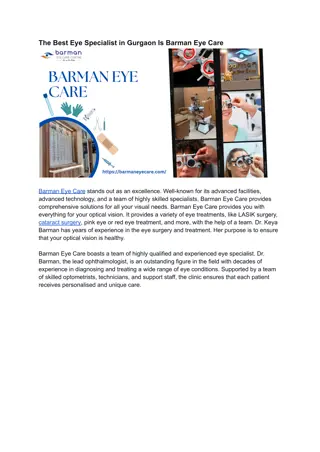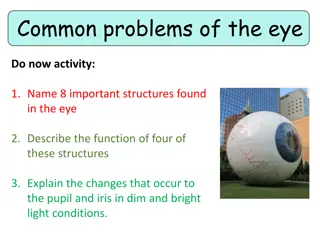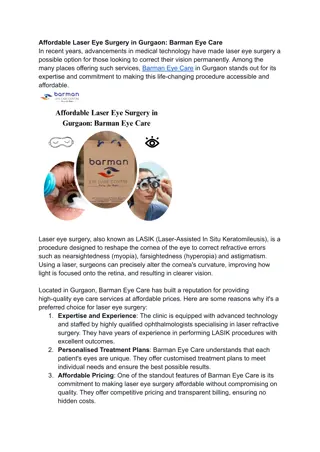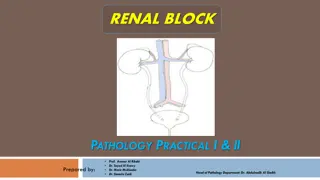Histology of the Eye
This detailed guide covers the histology of the eye, including the general structure and microscopic details of the cornea, retina, sclera, and more. Explore the layers and functions of the cornea, learn about the three tunics of the eye bulb, and discover the importance of structures like Descemet's membrane and the limbus.
Download Presentation

Please find below an Image/Link to download the presentation.
The content on the website is provided AS IS for your information and personal use only. It may not be sold, licensed, or shared on other websites without obtaining consent from the author. Download presentation by click this link. If you encounter any issues during the download, it is possible that the publisher has removed the file from their server.
E N D
Presentation Transcript
Objectives By the end of this lecture, the student should be able to describe: The general structure of the eye. The microscopic structure of: Cornea. Retina.
EYE BULB Three coats (3 Tunics): 1- Fibrous tunic: Cornea. Sclera. 2- Vascular tunic: Choroid. Ciliary body. Iris. 3- Neural tunic: Retina.
CORNEA It is the transparent, avascular and highly innervated anterior portion of the fibrous coat. It is composed of 5 distinct layers: 1. Corneal epithelium. 2. Bowman s membrane. 3. Stroma. 4. Descemet s membrane. 5. Corneal endothelium.
CORNEA (Cont.) Corneal epithelium: Non-keratinized Stratified squamous epithelium. Contains numerous free nerve endings. Bowman s membrane: It is homogenous non-cellular layer containing type I collagen fibrils.
CORNEA (Cont.) Stroma: It is the thickest layer (about 90%). It is composed of parallel lamellae of dense collagenous C.T. Each lamella is composed mainly of parallel type I collagen fibers with long fibroblasts.
CORNEA (Cont.) Descemet s membrane: It is a thick basement membrane. Corneal endothelium: It is s simple squamous epithelium. Functions: 1- Formation of Descemet s membrane. 2- Keeping the stroma relatively dehydrated (sod. pump water withdrawal from the stroma).
LIMBUS (CORNEO SCLERAL JUNCTION) It is the transition region between the cornea and sclera. It is about 1.5 mm width. It is highly vascular. It contains: 1. Trabecular meshwork: Endothelium-lined spaces. It leads to canal of Schlemm. 2. Canal of Schlemm: It drains the aqueous humor into the venous system. Cornea Canal of Schlemm Iris Sclera Ciliary body Lens
SCLERA It covers the posterior 5/6 of the fibrous tunic. Sclera Proper: consists of interlacing bundles of type I collagen (dense collagenous C.T., irregular type). Melanocytes are located in the deeper regions.
CHOROID It is the vascular, pigmented posterior portion of the middle vascular tunic. Structure: It is composed mainly of loose C.T. with melanocytes. It is separated from the retina by its Bruch s membrane.
CILIARY BODY It is the anterior continuation of the choroid. It surrounds the lens. Structure: It is formed of loose vascular and pigmented C.T. that contains 3 bundles of smooth muscle cells (ciliary muscle). Its inner surface is lined by pars ciliaris retinae ( 2 rows of columnar cells; outer pigmented and inner non- pigmented layers) . Its inner surface is highly folded forming the ciliary processes.
CILIARY PROCESSES Processes project from the inner surface of the anterior 1/3 of the ciliary body towards the lens. Are covered by pars ciliaris retinae (2 rows of columnar cells). They give attachment to the lens suspensory ligaments (zonule fibers).
IRIS It is formed of 5 layers: 1- Anterior border layer: Incomplete layer of fibroblasts and melanocytes. 2- Stroma: Poorly vascularized C.T. with fibroblasts and melanocytes. 3- Vessel layer: Well-vascularized loose C.T. Centrally, it contains circularly arranged smooth muscle fibers (sphincter pupillae muscle). Stroma
IRIS 4- Dilator pupillae muscle layer: Contains radially arranged myoepithelial cells. 5- Posterior surface layer (pigmented epithelium layer): It is composed of 2 rows of pigmented epithelial cells (pars iridis retinae). They are the continuation of pars ciliaris retinae. ====
RETINA It is composed of 10 distinct layers(from outside to inside): 1- Pigmented epithelium. 2- Rods and cones layer. 3- Outer limiting membrane. 4- Outer nuclear layer. 5- Outer plexiform layer. 6- Inner nuclear layer. 7- Inner plexiform layer. 8- Ganglion cell layer. 9- Optic nerve fiber layer. 10- Inner limiting layer.
RETINA (Cont.) Pigmented Epithelium: Cuboidal to columnar cells (single layer). Apical microvilli. Abundance of melanin granules. Functions: 1- Absorb light. 2- Phagocytosis of membranous discs from tips of rods. 3- Esterification of Vitamin A (in SER).
RODS AND CONES LAYER (Cont.) Are photoreceptor cells. Each has: 1. Dendrite formed of: -Outer segment (OS): contains membranous discs containing rhodopsin (in rods) and iodopsin (in cones). - Connecting Stalk: with modified cilium. -Inner segment (IS). 2. Cell body. 3. Axon: synapses with dendrite of bipolar neuron of inner nuclear layer. Functions: Rods are receptors for dim light ( low intensity light). Cones are receptors for bright light and color vision (red, green & blue).
RETINA (Cont.) Outer limiting membrane: A region of zonulae adherents junctions between Muller cells and the photoreceptors. Outer nuclear layer: Contains nuclei of the rods & cones. Outer plexiform layer: Contains axodendritic synapses between the photoreceptor cells and dendrites of bipolar and horizontal cells. Inner nuclear layer: Contains the nuclei of: 1- Bipolar neurons. 2- Horizontal neurons. 3- Amacrine neurons (unipolar neurons): 4- Neuroglial cells (Muller cells) that extend between the vitreous body and the inner segments of rods and cones.
RETINA (Cont.) Inner plexiform layer: Contains axodendritic synapses between axons of bipolar neurons and dendrites of ganglion cells and amacrine cells. Ganglion cell layer: Contains cell bodies of large multipolar neurons of the ganglion cells. Optic nerve fiber layer: Contains unmyelinated axons of the ganglion cells. N.B. These axons become myelinated as the nerve pierces the sclera. The inner limiting membrane: It is formed by the basal laminae of the Muller cells.
RETINA (Cont.) Fovea centralis: It lies in the center of macula lutea. Cones are highly concentrated in the fovea. It is responsible for visual acuity.
RETINA (Cont.) Types of cells in the retina: 1- Pigmented epithelium. 2- Nerve cells: - Photoreceptor cells (rods & cones) - Bipolar neurons. - Ganglion cells. - Association neurons: i. Horizontal cells. ii. Amacrine cells. 3- Neuroglial cells: - Muller s cells. - Astrocytes.
CONJUNCTIVA It is the transparent mucous membrane lining the inner surfaces of the eyelids (palpebral conjunctiva) and reflecting onto the sclera of the anterior surface of the eye (bulbar conjunctiva). L/M: 1- Epithelium: Stratified columnar epithelium with numerous goblet cells. 2- Lamina propria: Loose C.T.
GOOD GOOD LUCK LUCK
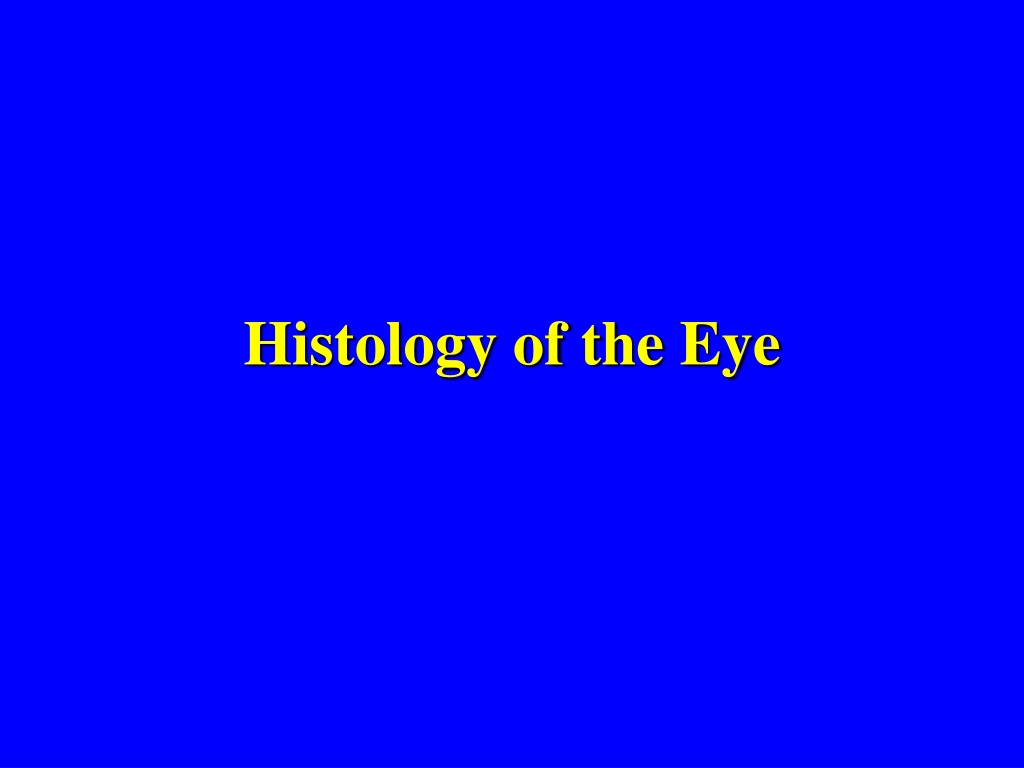
 undefined
undefined








